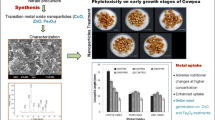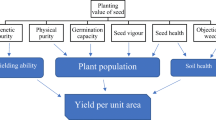Abstract
Rapid utilization of nano-based products will inevitably release nanoparticles into the environment with unidentified consequences. Plants, being an integral part of ecosystem play a vital role in the incorporation of nanoparticles in food chain and thus, need to be critically assessed. The present study assesses the comparative phytotoxicity of nanoparticle, bulk and ionic forms of zinc at different concentrations on selected plant species with varying seed size and surface anatomy. ZnO nanoparticles were chosen in view of their wide spread use in cosmetics and health care products, which allow their direct release in the environment. The impact on germination rate, shoot & root length and vigour index were evaluated. A concentration dependent inhibition of seed germination as well as seedling length was observed in all the tested plants. Due to the presence of thick cuticle on testa and root, pearl millet (xerophytic plant) was found to be relatively less sensitive to ZnO nanoparticles as compared to wheat and tomato (mesophytic plants) with normal cuticle layer. No correlation was observed between nanoparticles toxicity and seed size. The results indicated that variations in surface anatomy of seeds play a crucial role in determining the phytotoxicity of nanoparticles. The present findings significantly contribute to assess potential consequences of nanoparticle release in environment particularly with major emphasis on plant systems. It is the first report which suggests that variations observed in phytotoxicity of nanoparticles is mainly due to the predominant differences in size and surface anatomy of tested plant seeds and root architecture.
Graphical abstract
Effect of various concentrations of nano ZnO, bulk ZnO and zinc sulphate on the growth of pearl millet (A), tomato (B) and wheat (C) seedlings.







Similar content being viewed by others
References
Albrecht MA, Evans CW, Raston CL (2006) Green chemistry and the health implications of nanoparticles. Green Chem 8:417–432
AOSA (Association of Official Seed Analysts) (1983) Seed vigor testing handbook. AOSA, Ithaca, NY, (Contribution to the Handbook on Seed Testing, 32)
Auffan M, Rose J, Bottero JY, Lowry GV, Jolivet JP, Wiesner MR (2009) Towards a definition of inorganic nanoparticles from an environmental, health and safety perspective. Nature Nanotech 4:634–641
Baud-Grasset S, Baud-Grasset F, Bifulco JM, Meier JR, Ma TH (1993) Reduction of genotoxicity of a creosote-contaminated soil after fungal treatment determined by the Tradescantia-micronucleus test. Mut Res 303:77–82
Begum P, Ikhtiari R, Fugetsu B, Matsuoka M, Akasaka T, Watari F (2012) Phytotoxicity of multi-walled carbon nanotube assessed by selected plant species in the seedling stage. Appl Surface Sci 262:120–124
Boonyanitipong P, Kositsup B, Kumar P, Baruah S, Dutta J (2011) Toxicity of ZnO and TiO2 nanoparticles on germinating rice seed Oryza sativa L. Int J Biosci, Biochem Bioinform 1:282–285
Cabello-Hurtado F, Lozano-Baena MD, Neaime C, Burel A, Jeanne S, Pellen-Mussi P, Cordier S, Grasset F (2016) Studies of plant cell toxicity of luminescent silica nanoparticles (CS2[Mo6Br14]@SiO2) and its constitutive components. J Nanopart Res 18:69–83
Canas JE, Long M, Nations S, Vadan R, Dai L, Luo M, Ambikapathi R, Lee EH, Olszyk D (2008) Effects of functionalized and nonfunctionalized single-walled carbon nanotubes on root elongation of select crop species. Environ Toxicol Chem 27:1922–1931
Dietz KJ, Herth S (2011) Plant nanotoxicology. Trends Plant Sci 16:582–589
Di Salvatore M, Carafa AM, Carratù G (2008) Assessment of heavy metals phytotoxicity using seed germination and root elongation tests: a comparison of two growth substrates. Chemosphere 73:1461–1464
Franklin NM, Rogers NJ, Apte SC, Batley GE, Gadd GE, Casey PS (2007) Comparative toxicity of nanoparticulate ZnO, bulk ZnO, and ZnCl2 to a freshwater microalga (Pseudokirchneriella subcapitata): the importance of particle solubility. Environ Sci Technol 41:8484–8490
Guthrie RL (1989) Xylem structure and ecological dominance in a forest community. Am J Bot 76:1216–1228
Handy RD, Owen R, Valsami-Jones E (2008) The ecotoxicology of nanoparticles and nanomaterials: current status, knowledge gaps, challenges, and future needs. Ecotoxicology 17:315–325
ISTA (International Seed Testing Association) (2010) International rules for seed testing. International Seed Testing Association, Bassersdorf. Switzerland
Jain N, Bhargava A, Majumdar S, Tarafdar JC, Panwar J (2011) Extracellular biosynthesis and characterization of silver nanoparticles using Aspergillus flavus NJP08: a mechanism perspective. Nanoscale 3:635–641
Jain N, Bhargava A, Tarafdar JC, Singh SK, Panwar J (2013) A biomimetic approach towards synthesis of zinc oxide nanoparticles. Appl Microbiol Biotechnol 97:859–869
Ju-Nam Y, Lead JR (2008) Manufactured nanoparticles: an overview of their chemistry, interactions and potential environmental implications. Sci Total Environ 400:396–414
Kagan CR (2016) At the nexus of food security and safety: opportunities for nanoscience and nanotechnology. ACS Nano 10:2985–2986
Lin D, Xing B (2007) Phytotoxicity of nanoparticles: Inhibition of seed germination and root growth. Environ Pol 150:243–250
Lin D, Xing B (2008) Root uptake and phytotoxicity of ZnO nanoparticles. Environ Sci Technol 42:5580–5585
Liu J, Hurt RH (2010) Ion release kinetics and particle persistence in aqueous nano-silver colloids. Environ Sci Technol 44:2169–2175
Lopez-Moreno ML, de la Rosa G, Hernandez-Viezcas JA, Castillo-Michel H, Botez CE, Peralta-Videa JR, Gardea-Torresdey JL (2010) Evidence of the differential biotransformation and genotoxicity of ZnO and CeO2 nanoparticles on soybean (Glycine max) plants. Environ Sci Technol 44:7315–7320
Love SA, Maurer-Jones MA, Thompson JW, Lin YS, Haynes CL (2012) Assessing nanoparticle toxicity. Ann Rev Anal Chem 5:181–205
Luyts K, Napierska D, Nemery B, Hoet PHM (2013) How physico-chemical characteristics of nanoparticles cause their toxicity: complex and unresolved interrelations. Environ Sci: Process Impact 15:23–38
Ma X, Geisler-Lee J, Deng Y, Kolmakov A (2010) Interactions between engineered nanoparticles (ENPs) and plants: phytotoxicity, uptake and accumulation. Sci Total Environ 408:3053–3061
Mabille F, Gril J, Abecassis J (2001) Mechanical properties of wheat seed coats. Cereal Chem 78:231–235
Nel A, Xia T, Madler L, Li N (2006) Toxic potential of materials at the nanolevel. Science 311:622–627
Nohynek GJ, Lademann J, Ribaud C, Roberts MS (2007) Grey goo on the skin? Nanotechnology, cosmetic and sunscreen safety. Crit Rev Toxicol 37:251–277
Nowack B, Bucheli TD (2007) Occurrence, behavior and effects of nanoparticles in the environment. Environ Pol 150:5–22
Oberdörster G, Oberdörster E, Oberdörster J (2005a) Nanotoxicology: an emerging discipline evolving from studies of ultrafine particles. Environ Health Persp 113:823–839
Oberdörster G, Maynard A, Donaldson K, Castranova V, Fitzpatrick J, Ausman K, Carter J, Karn B, Kreyling W, Lai D, Olin S, Monteiro-Riviere N, Warheit D, Yang H (2005b) Principles for characterizing the potential human health effects from exposure to nanomaterials: elements of a screening strategy. Part Fibre Toxicol 2:1–8
OECD (2006) Test no. 208: terrestrial plant test: seedling emergence and seedling growth test. OECD Publishing, Paris
Olenin AY, Krutyakov YA, Kudrinskii AA, Lisichkin GV (2008) Formation of surface layers on silver nanoparticles in aqueous and water-organic media. Colloid J 70:71–76
Parak WJ, Nel AE, Weiss PS (2015) Grand challenges for nanoscience and nanotechnology. ACS Nano 9:6637–6640
Prasad TNVKV, Sudhakar P, Sreenivasulu Y, Latha P, Munaswamy V, Reddy KR, Sreeprasad TS, Sajanlal PR, Pradeep T (2012) Effect of nanoscale zinc oxide nanoparticles on the germination, growth and yield of peanut. J Plant Nut 35:905–927
Rico CM, Majumdar S, Duarte-Gardea M, Peralta-Videa JR, Gardea-Torresdey JL (2011) Interaction of nanoparticles with edible plants and their possible implications in the food chain. J Agri Food Chem 59:3485–3498
Shaymurat T, Gu J, Xu C, Yang Z, Zhao Q, Liu Y, Liu Y (2012) Phytotoxic and genotoxic effects of ZnO nanoparticles on garlic (Allium sativum L.): a morphological study. Nanotoxicology 6:241–248
Stampoulis D, Sinha SK, White JC (2009) Assay-dependent phytotoxicity of nanoparticles to plants. Environ Sci Technol 43:9473–9479
US EPA (Environmental Protection Agency) (2012a) Ecological effects test guidelines. OCSPP, Washington, DC, 850.4100, seedling emergence and growth. EPA 712-C-012
US EPA (Environmental Protection Agency) (2012b) Ecological effects test guidelines. OCSPP, Washington, DC, 850.4150, Vegetative Vigor. EPA 712-C-011
Van der Burg WJ, Aartse JW, Van Zwol RA, Jalink H, Bino RJ (1994) Predicting tomato seedling morphology by X-ray analysis of seeds. J Am Soc Hort Sci 119:258–263
Wang P, Lombi E, Zhao FJ, Kopittke PM (2016) Nanotechnology: a new opportunity in plant sciences. Trends Plant Sci 21:699–712
Wang P, Menzies NW, Lombi E, McKenna BA, Johannessen B, Glover CJ, Kappen P, Kopittke PM (2013) Fate of ZnO nanoparticles in soil and cowpea (Vigna unguiculata). Environ Sci Technol 47:13822–13830
Wang ZL (2004) Zinc oxide nanostructures: Growth, properties and applications. J Phys Condens Mattter 16:829–858
Wu SG, Huang L, Head J, Chen DR, Kong IC, Tang YJ (2012) Phytotoxicity of metal oxide nanoparticles is related to both dissolved metal ions and adsorption of particles on seed surface. J Pet Environ Biotechnol 3:1000126
Zeng H, Cai W, Li Y, Hu J, Liu P (2005) Composition/structural evolution and optical properties of ZnO/Zn nanoparticles by laser ablation in liquid media. J Phy Chem B 109:18260–18266
Zhang Y, Chen Y, Westerhoff P, Hristovski K, Crittenden JC (2008) Stability of commercial metal oxide nanoparticles in water. Water Res 42:2204–2212
Acknowledgements
This research work was financially supported by the Indian Council of Agricultural Research, Government of India under the National Agricultural Innovation Project scheme (NAIP/C4/C-2032). Facilities provided by the Birla Institute of Technology and Science, Pilani are gratefully acknowledged. Navin Jain and Arpit Bhargava thank the Council of Scientific and Industrial Research, Government of India for providing research fellowship.
Author information
Authors and Affiliations
Corresponding author
Ethics declarations
Conflict of interest
The authors declare that they have no conflict of interest.
Research involving Human Participants and/or Animals
The present work does not involve any human participant and/or animals.
Informed consent
Informed consent is not applicable to the present work.
Rights and permissions
About this article
Cite this article
Jain, N., Bhargava, A., Pareek, V. et al. Does seed size and surface anatomy play role in combating phytotoxicity of nanoparticles?. Ecotoxicology 26, 238–249 (2017). https://doi.org/10.1007/s10646-017-1758-7
Accepted:
Published:
Issue Date:
DOI: https://doi.org/10.1007/s10646-017-1758-7




